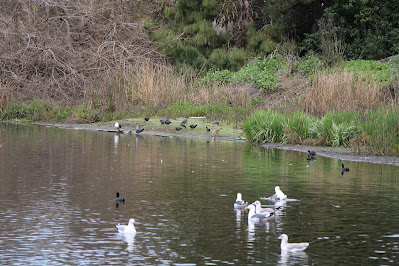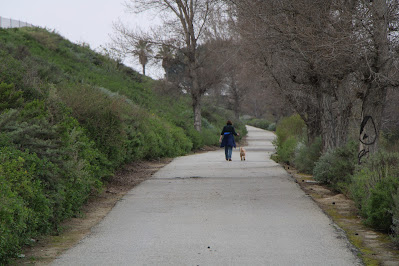The afternoon sky is sunny with temperatures in the upper 70’s as Caroline, Riley and I explore the botanical garden in the 18-acre, Polliwog Park in the city of Manhattan Beach, California. Just off the trail, I watch several honeybees feeding on blossoms of Rosemary. Nearby, I spot a never-before-seen Sonoran Bumble Bee, gathering pollen from a Purple Sage blossom. Right away, I notice its yellow fur, very large size (about 1 ½ inches long) and hairy legs that are used to collect and carry pollen to the hive. Although these bees sting, the symptoms are similar to others. Like other pollinators, this species has been in decline since the 1990’s, similar to their honeybee relatives. After pausing by a gently flowing creek, I proceed past colorful blossoms of Rosy Mallow and California Lilac. Unlike Michigan Lilacs, this shrub is evergreen. Like Michigan Lilacs, the blossoms have a lovely fragrance. Leaving the botanical garden, we proceed downhill to a large, man-made lake where I spot a few American Wigeon ducks, with both males and females displaying similar plumage. During the breeding season, males’ contrasting colors (stock photo) are used in courtship displays to attract females and discourage competing males. Wigeons are the most vegetarian of dabbling ducks, eating the stems and leafy parts of aquatic plants, leafy parts of grasses, and leaves and seeds of some marsh and crop plants. They were formerly known as "Baldpate" because the white stripe on the male’s crown resembled a bald man's head. Near the water’s edge, I spot a California Gull standing next to one of many basking, Red-eared Slider turtles with its distinctive colorful ear. These reptiles feed mainly on plants and small animals, such as crickets, fish, crayfish, snails, tadpoles, worms, aquatic insects and aquatic plants. Because of their popularity as pets, these non-native turtles have invaded freshwater habitats like this one, competing with native western pond turtles for food, egg-laying sites, and basking sites. Nearby, I observe a pair of these turtles swimming along, partially submerged. While they can hold their breath up to 30 minutes, they are able to sleep underwater for hours. Up ahead, I notice a few swimming Mallards and American Coots. On the far shore, I see the wispy seed heads of Pampas Grass. Introduced to California in 1848 by nursery operators, this grass has spread all over the state, threatening native plants and the animals that rely on them. Turning back toward the car, I look overhead to see the colorful blossoms of a Red-flowering Gum tree.
High in a Sycamore
Or on a field below
Honk of a Canada goose
Caw of a common Crow
Noisy jay of blue
Quiet Cardinal of red
White breast of a Phoebe
Black cap on its head
Some perch or swim
Other ones in flight
Nature’s winged wonders
Afternoon delight
D. DeGraaf



